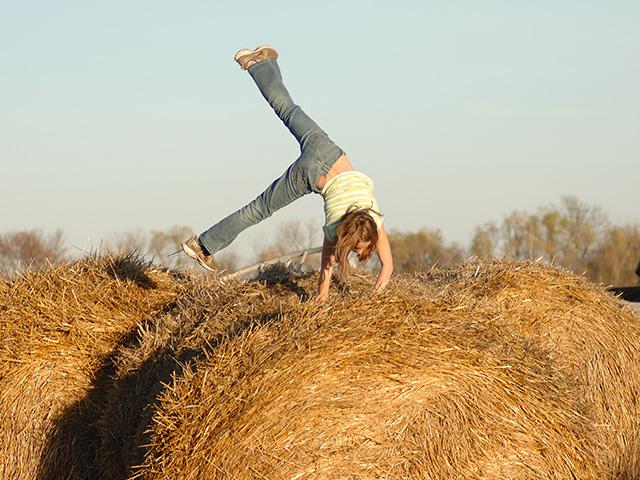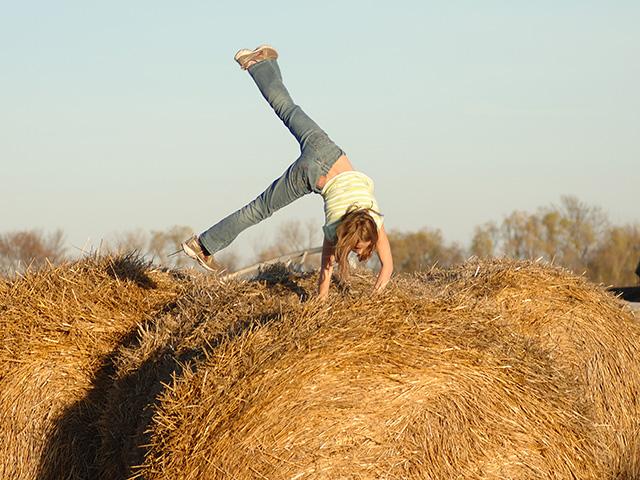MachineryLink
Farms Have Several Positives but Also Hazards for Youth
As most anyone who has spent time during childhood on a farm will tell you, there are many benefits to spending time on a working farm. Most learn a good work ethic, and as a kid, you literally have acres and acres for your personal playground.
When I was growing up, we played on lined-up round bales of hay, skated on the ice of farm ponds, and I had my own indoor basketball court. Well, it was only a half-court, and I had to move some small square bales of hay to the other end of the haymow of the barn and also sweep the floor. Oh, and not fall down the hole in the floor to throw the bales downstairs, although a piece of plywood and a cement block took care of this hazard. There were no lay-ups on my court because of the hole being directly under the basket, but you could shoot straight on well beyond the pro three-point line.
While there are many benefits to growing up on a farm, there are also many hazards. Youth are often injured and killed on farms, both helping to operate the farm and also just being a kid.
The issue of youth safety was the topic of a recent Farm Safety Webinar Series from North Dakota State University Extension and the University of Minnesota Extension. The hour-long webinar can be viewed at https://www.ag.ndsu.edu/….
Marsha Salzwedel, a project scientist with the National Children's Center for Rural and Agricultural Health and Safety (https://www.marshfieldresearch.org/…), said in the webinar that a child dies in an agriculture-related accident about every three days. (This was from reported deaths annually between 1995 and 2000.)
Every day, an estimated 33 children are injured in agriculture-related incidents. In 2014, an estimated 7,469 youths were injured on a farm, and 60% of these kids were not working when the injury occurred. In addition, an estimated 738 hired youth were injured on farms in 2014, and approximately 3,735 visiting youth were injured on farms that same year.
These numbers of injuries and deaths in agriculture are grim, but they may also be underestimated.
"There may be over four times more injuries than are reported," the National Children's Center for Rural and Agricultural Health and Safety stated in a fact sheet. "As many as 88% of agricultural injuries and illnesses are not captured by traditional surveillance methods. There is no central repository of childhood agricultural injuries." The Center instead draws from the best available data (https://marshfieldresearch.org/…).
P[L1] D[0x0] M[300x250] OOP[F] ADUNIT[] T[]
There are several hazards on a farm for small children.
Diane Rohlman with the University of Iowa College of Public Health (https://www.public-health.uiowa.edu/…) said all-terrain vehicles (ATV) and utility-terrain vehicles (UTV) are at the top of the list of hazards for children on farms. The National Children's Center for Rural and Agricultural Health and Safety reported that 47% of all accidents involving youth on the farm involved transportation, including tractors, ATVs and UTVs.
Youth under the age of 16 have 12 times the risk of ATV injuries compared to adults, Salzwedel said.
Livestock is another source of injuries. About 13% of farm accidents with children involved violent contact with animals.
Rohlman said youth can also see longer-term negative effects from being and working on a farm. Hearing losses from being around loud equipment, and respiratory issues from not wearing the proper personal protection equipment (PPE) inside livestock buildings can have long-lasting effects on young people.
"Unfamiliar tasks to inexperienced workers can lead to accidents," Rohlman said. "Or being in a hurry or taking short-cuts can be dangerous."
Salzwedel said fatality rates increase with young ag workers when they do not fully understand a task. Supervisors should watch the youth's ability to do a job, she added.
Some 16-year-olds might be mature enough to do machinery chores on a farm, for instance. Others that same age, however, might not be able to do the same tasks, she explained.
"We could cut the number of accidents in half if more questions were asked," Salzwedel said.
Jana Davidson with Progressive Agriculture Foundation (https://www.progressiveag.org/…) said most incidents are preventable. Supervisors, which can be nonfarm supervisors or even parents or other family members on a family farm, need to be good role models for youth when it comes to farm safety.
"Kids see a farm as a giant play area, and thus, adults need to set the boundaries," Davidson said.
These boundaries can come in the form of several different safety rules and equipment. Not having extra riders on machinery, utilizing PPE and helmets, and keeping children out of busy areas are just a few practices that can make farms safer, she said.
When I was growing up, I don't ever remember my parents having specific safety rules on the farm. They were more general commonsense things like to stay out of the cow lots and to stay in the fenced-in area right around the house.
We did the same thing when my wife and I had our own kids on our farm. We put a chain-link fence around our backyard, and this was where the kids played when they were younger, unless we were outside, and then they could go in the front yard.
As the kids got older, we relaxed this rule, and they mainly played around the house and away from the buildings and farmyard. So far, so good.
The rule about not going into cow lots, by the way, was adopted from my childhood.
Russ Quinn can be reached at russ.quinn@dtn.com
Follow him on Twitter @RussQuinnDTN
(c) Copyright 2021 DTN, LLC. All rights reserved.





Comments
To comment, please Log In or Join our Community .